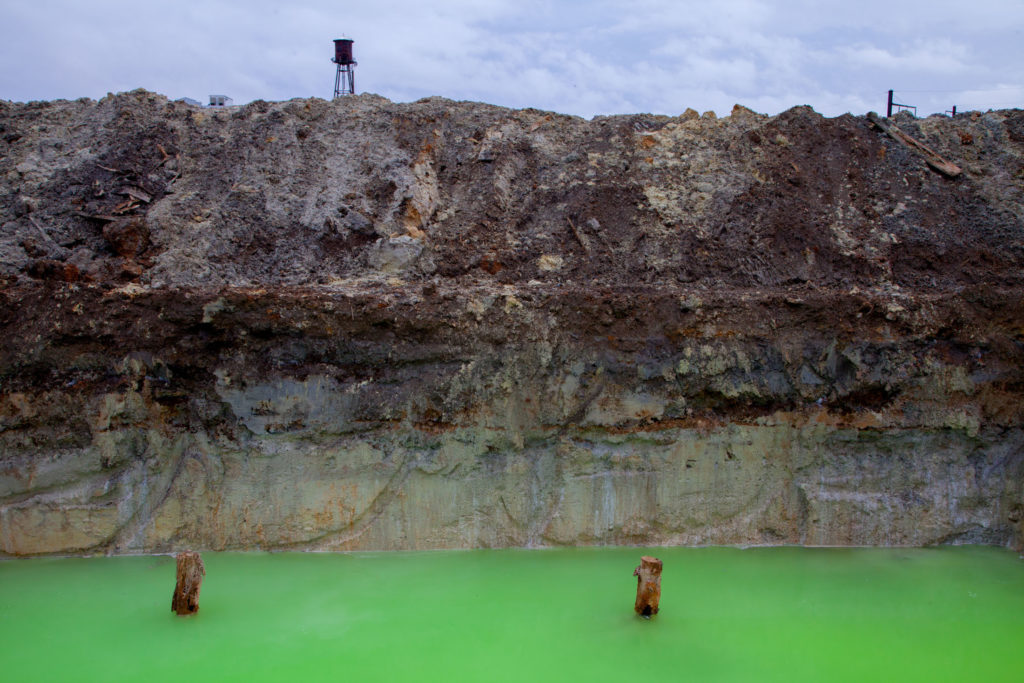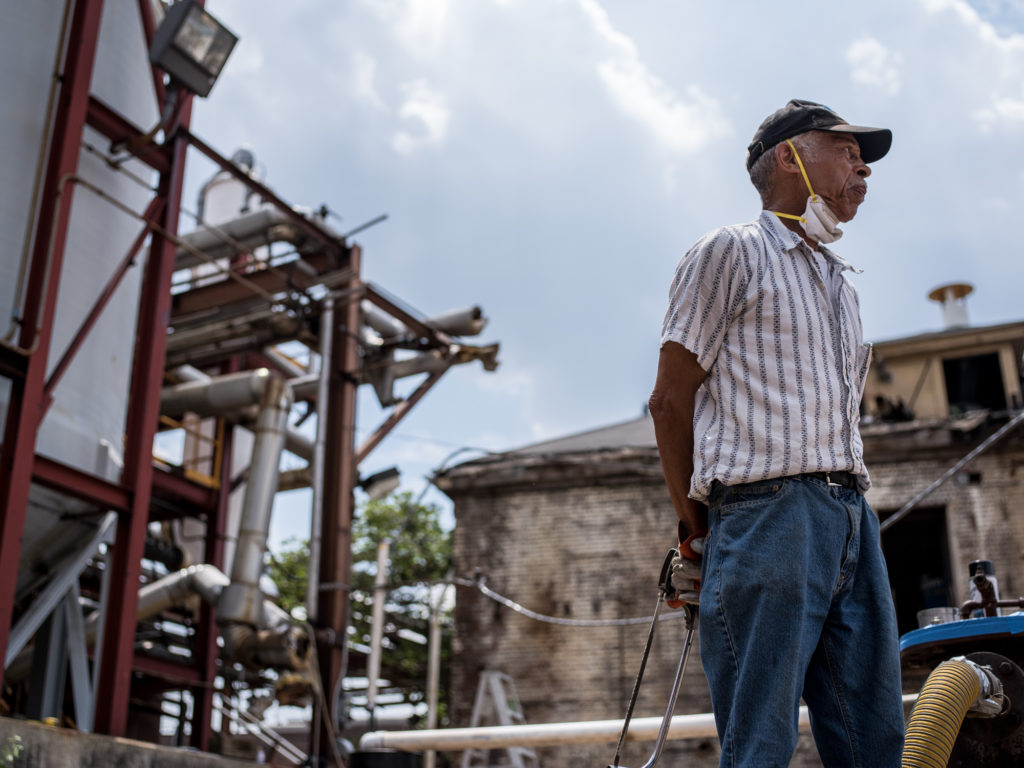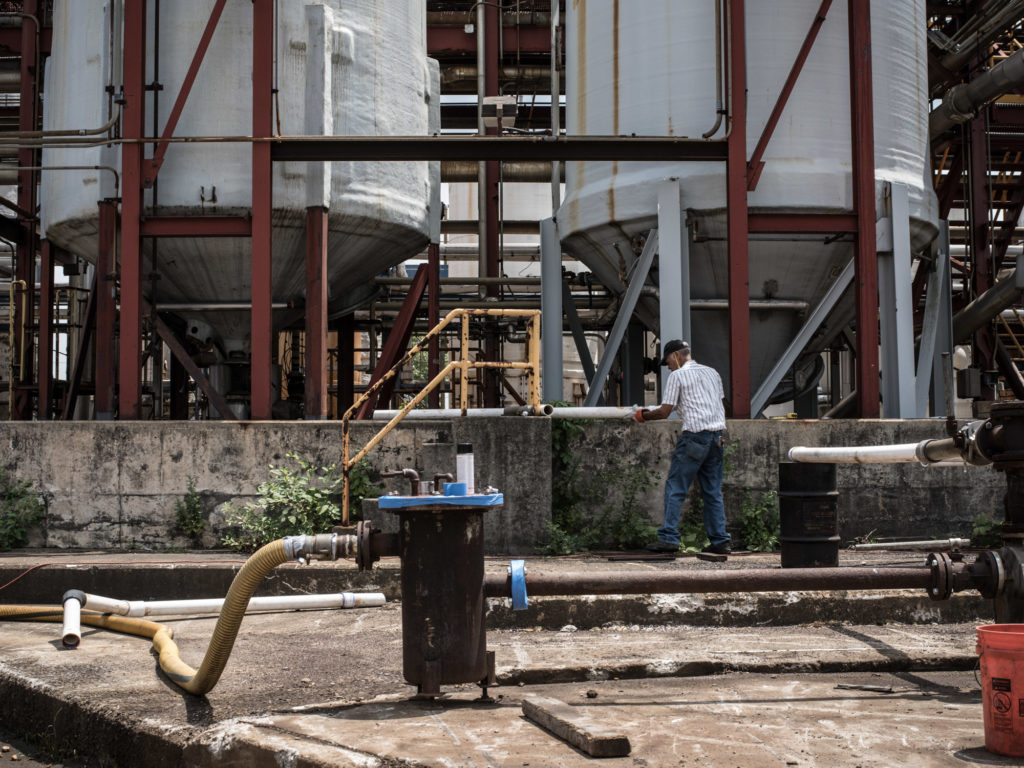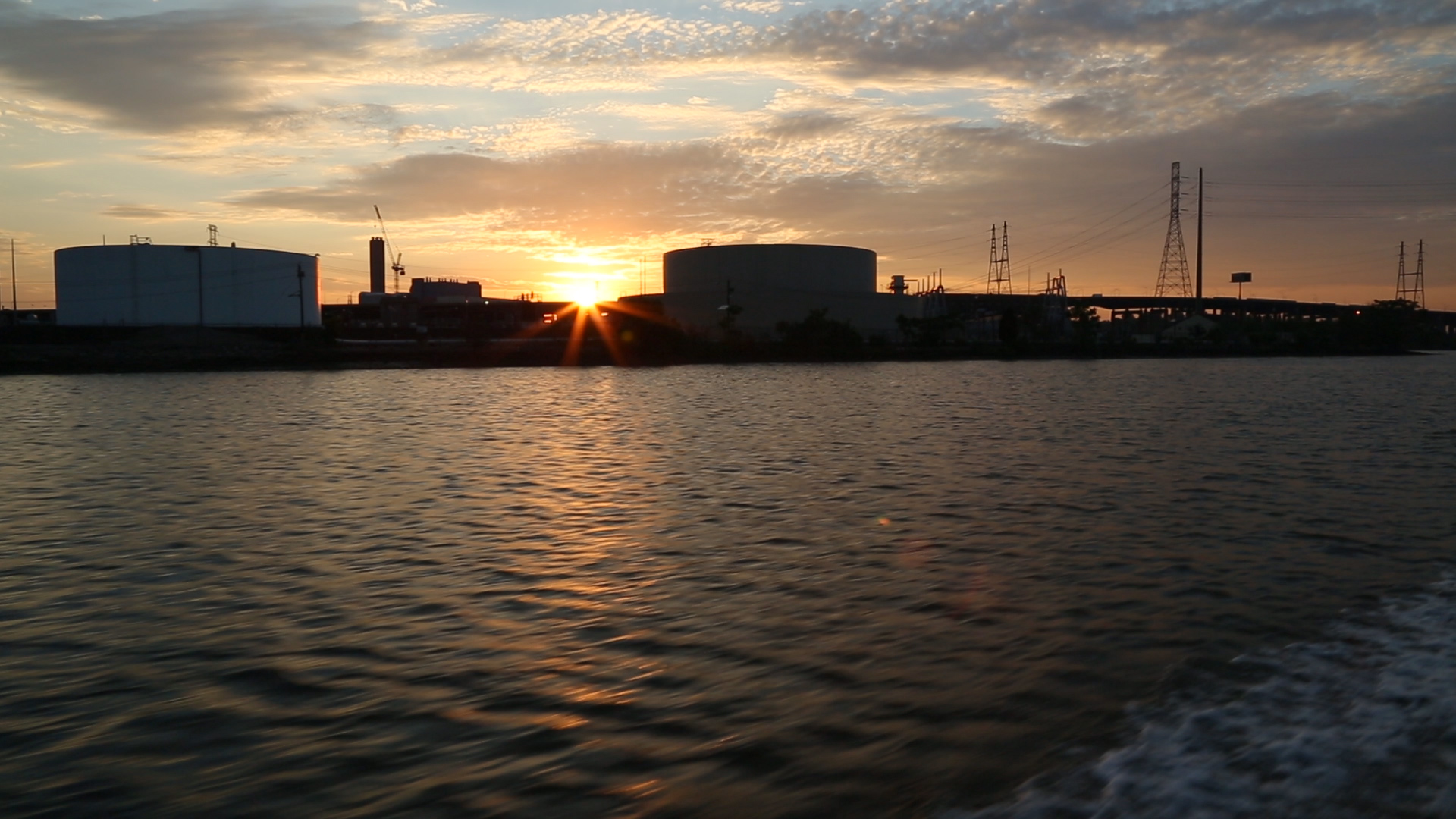Rome & Hawkins Street
Alfredo breaks down an air conditioner in the back of a pickup truck. He unbuckles the compressor, then the fan. Born in the Dominican Republic, and now a resident of Newark, New Jersey, Alfredo Hernandez has come to the edge of Newark’s Ironbound neighborhood, where freight train tracks enclose the eastern boundary of the city, to sell his scrap metal to Sims Metal Management. Like the labor of many men of color along the rail lines in the Ironbound, Alfredo’s work collecting, breaking down, and selling scrap metal is a crucial part of the postindustrial American economy. Yet, it is a form of work that is often invisible in the larger mosaic of American labor.
It’s not insignificant that we meet Alfredo at the end of a street, at the edge of the Ironbound. Edges are rarely incidental. They teach us about the forces that shape a place, the forces that bind them. Understanding the Ironbound––a community of 50,000 people literally bound by freight and passenger rail lines, metal yards and chemical factories––is about taking edges seriously. It is about following those edges and the communities bound by them. As I turn away from Alfredo, my back to the edge of the Ironbound and the rest of me facing its center, I see houses, a young girl walking into a community center, and I hear the noise of three highways above me. That’s the thing about this place: the edges are loud, visually persistent, and are never very far from the community’s center. My photographer friend and I follow Alfredo’s scrap metal down the tracks.
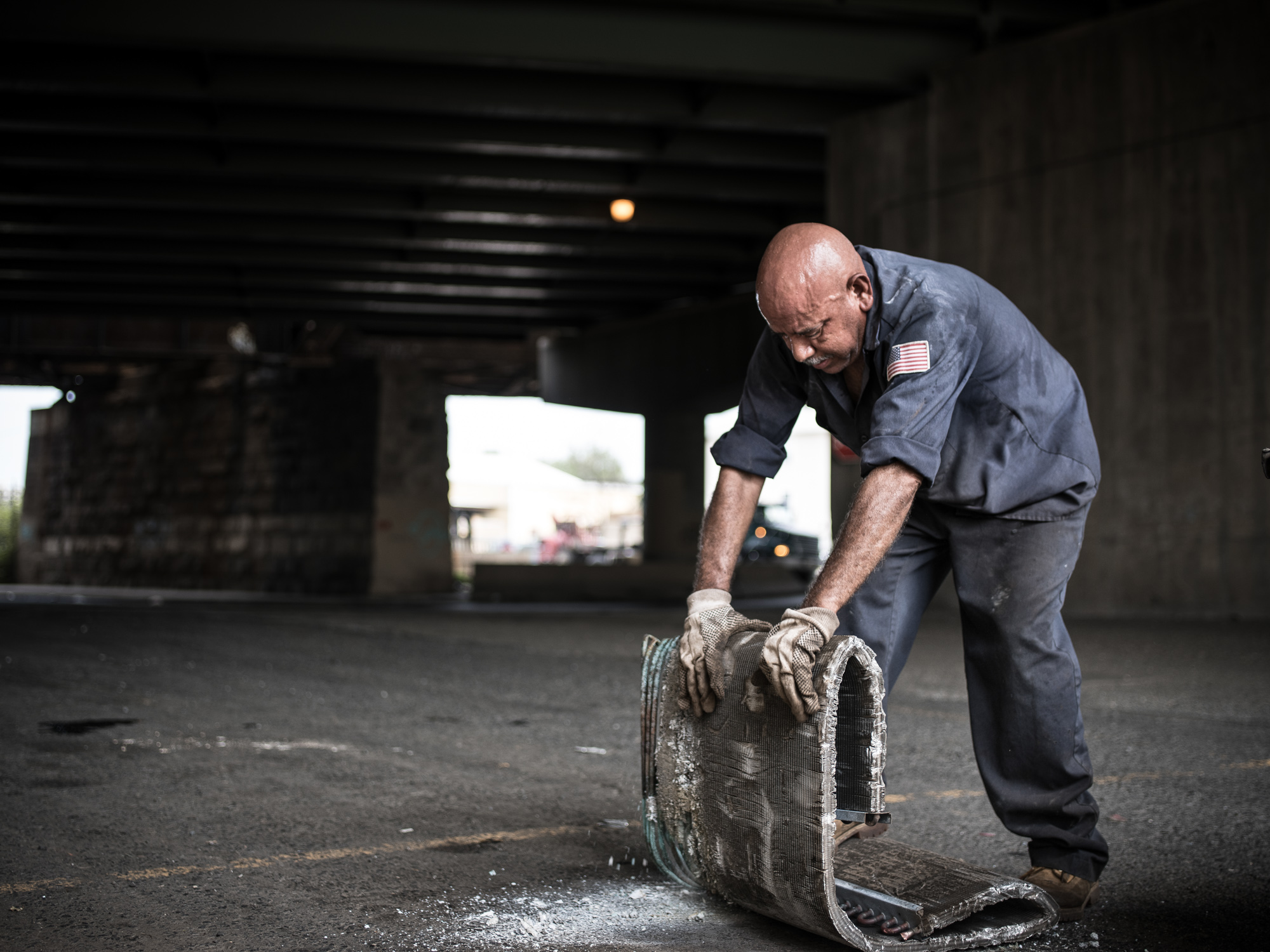
Conrail Assets Operation Yard, Delancey Street
Alfredo’s metal is loaded onto a railcar behind Sims and that railcar runs on train tracks that pass by the Ironbound’s Oak Island Yard, the state’s largest rail facility at 500 acres, and then through Conrail’s Shared Assets Operation Yard (CSAO), a terminal and switching services space, a mile southwest of Sims. Oak Island and CSAO are arteries in the state’s shipping body, responsible for large portions of New Jersey’s export of roughly 3 million tons of scrap metal per year. By 10:00 a.m., beneath the same knot of highway systems that ran above Hawkins Street, the trains have already carried three different types of freight––lumber, grain, and a mile-long shipment of oil––east and west along the edges of the Ironbound.

The landscape feels like an industrial, chemical frontier. It is dominated by freight containers, at least one creek contaminated with mercury recently declared a superfund site, and several unspecified contaminated areas under investigation by the EPA. You’d never guess, standing in the yard, that roughly 27,000 people live within a one-mile radius. More precisely, the census reports a population of 3,585 people in Essex County tract 71, the very tract that contains the CSAO yard. So, as much as this rail space might feel like an industrial frontier, it is not.
Instead, it is home to working people and families who have learned to persist amid and despite considerable infrastructural and environmental burdens; who have carved out recreational, residential and labor spaces in a city that has over 680 active contaminated sites and 4 Superfund sites.
Building freight rail lines so close to a community has consequences. Plastic resins, fertilizers, various industrial chemicals, ethanol, and oil circulate around the edges of the Ironbound every day. Considering that New Jersey alone is responsible for the import of 6.2 million tons of chemicals per year and given that Oak Island Yard is the biggest rail facility in the state, many of those chemicals undoubtedly pass along the edge––that edge which is never very far from the center––of the Ironbound.
When we walk along the rail tracks that lead out of Oak Island and into CSAO, we see grain has spilled onto the soil beneath the tracks.
What else has spilled that we cannot see?
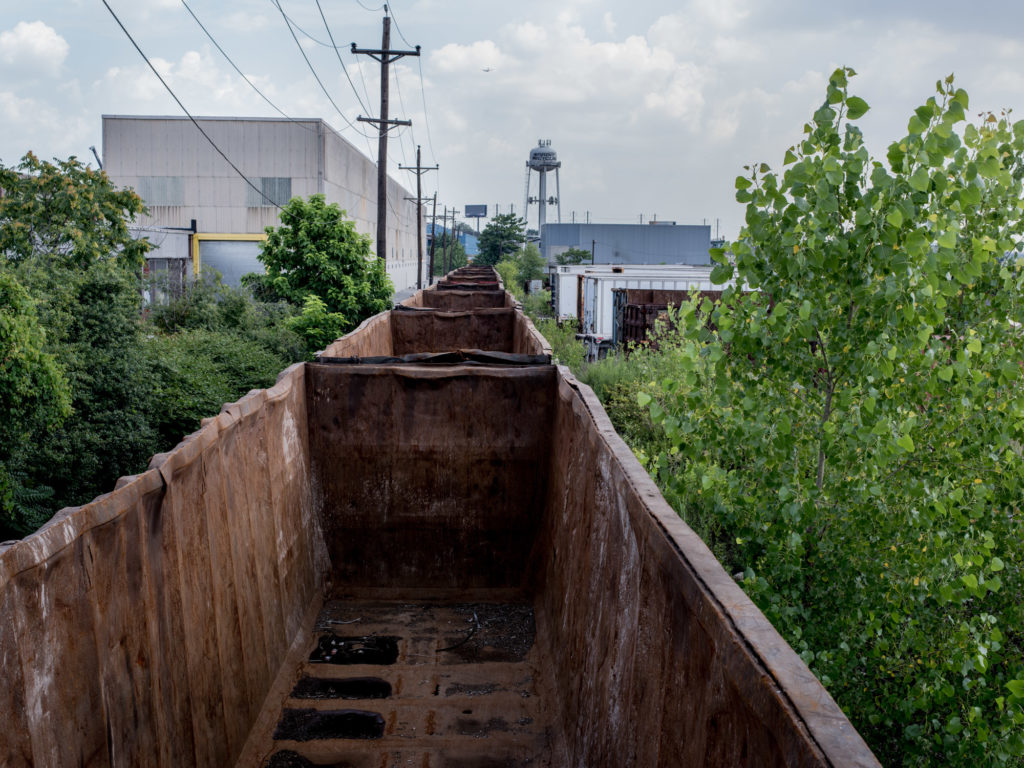
Avenue C & Vanderpool Street
It’s Sunday in the Ironbound and the stone columns of the skate park on Avenue C feel almost Grecian. In fact, the whole building––an abandoned industrial warehouse repurposed by Ironbound youth as a skate park––has the look and feel of a Greek temple. Three teenage girls sit near the edge of a bench, matte lipstick intact. Ceiling to floor graffiti art covers every inch of interior except for the floor. “The guys who own the buildings back there,” says one of the Portuguese teens who lives a few blocks away, “they gave us the warehouse.” A gift, I think, and continue listening. He says that the spot is a gathering place for local kids as well as skaters from around the east coast who travel to Newark to skate in this community-built park. 700 feet south of Shorty’s skate park, the Conrail freight tracks continue to stretch.
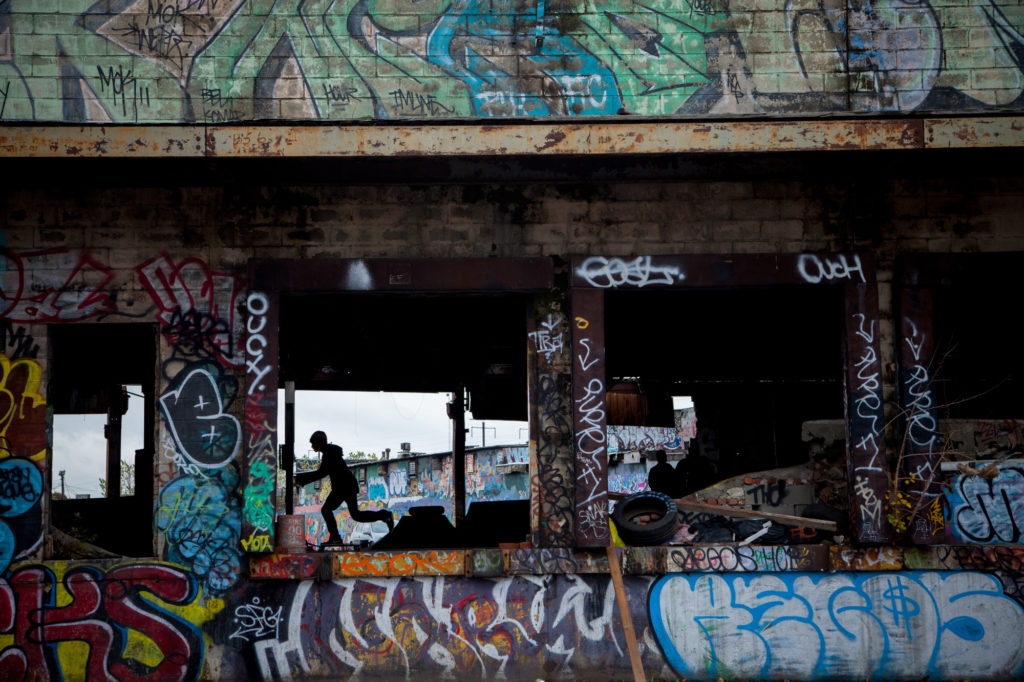
Another hot summer day, but the heat is breaking into a different sort of climate here. Mugwort and phragmite grass crowd the edge of the warehouse, relics of the marshland that the industrial landscape was built on top of centuries ago. On the other side of the skate park, an Ecuadorian volleyball game is underway. The court is the old parking lot that belonged to the warehouse, the Grecian-skate-temple. Next to the game, there are two tents under which Ecuadorian women are grilling a late lunch. Charcoal fills the air and I introduce myself to a mother and daughter, Lucia and Silvana, sitting at the edge of the court, halfway between the game and the food. They have come to Avenue C today to cheer on Lucia’s father who is part of the game. There’s a little wind in the air, enough to swirl dust up off the volleyball court. Lucia’s father’s friend comes over with a broom during a break in the game and sweeps the dust off of the court, moving it to the edge of the skate park.
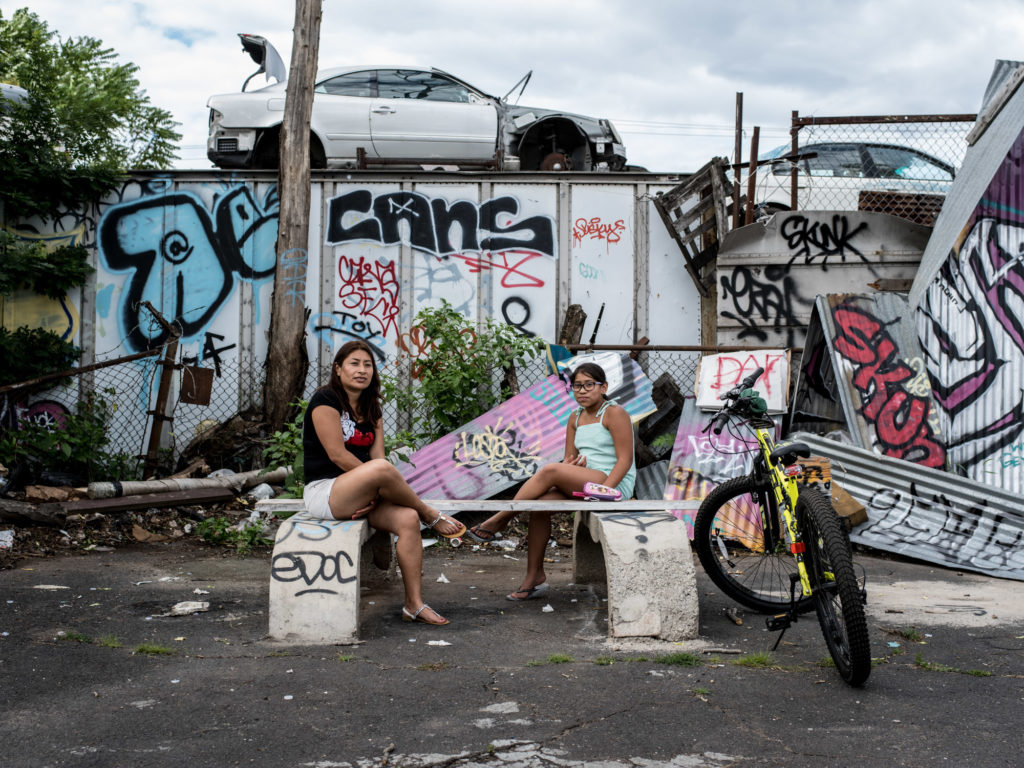
The thing about wind along Avenue C is that it stirs things up, things that would be better off left unstirred. Behind the volleyball court and skate park, directly between the Conrail tracks and where I sit with Lucia and Silvana, there is a place called Cookson Pigments. Cookson is part of the Vanderpool facility, what the city has called “a sprawling, derelict, hazardous 14-acre wasteland.” In 2015, the city of Newark filed a lawsuit in federal court against Cookson and other companies who have historically operated pigment plants on Vanderpool Street, including the infamous Dupont Chemical Corporation. The suit charges these companies with contaminating the 45-acre site and never cleaning it up.

Recent testing cited in the city’s 2015 suit measured chromium levels as high as 27,300 parts per million at depths less that two feet from the surface at Cookson Pigments, more than 1,300 times the standard for such a chemical at twenty feet below the surface. Lead measured 130 parts per million less than a foot from the surface, over 400 times the maximum in New Jersey.
Between 1989 and 1998, Cookson reported on-site releases of over 17 different chemicals, including but not limited to hexavalent chromium and lead, both human carcinogens. More specifically, over ten years of operation, Cookson documented releases of 2,829 pounds of chromium and 16,336 pounds of lead into the Ironbound environment, everything from surface water discharges to land and air releases. Lead and chromium leach into groundwater and soil. Chromium enters the human body through inhalation, ingestion, and dermal contact; lead, through breathing lead-laden dust or dirt, or through eating lead-contaminated foods and drinking water.
Because lead and chromium are both elements, they will never disappear from the Ironbound unless they are removed. While they remain in the Ironbound, they have the capacity to move around. I guess it’s the moving that scares me the most. “The Facility’s contamination has spread far beyond its borders,” writes the City of Newark in its complaint to the United States District Court. I think about this as Lucia and Silvana sit on the side of the court, their feet brushing up against the muggy earth. I think of this as the wind swirls that same earth up into the air and past all of our mouths. I think back to how the skaters described acquiring Shorty’s. Some gift.

Toxic exposure in the section of the Ironbound near Cookson Pigments means endangering a community of 13,444 Africans American and 12,434 Hispanic folks within a one-mile radius.
The ghosts of toxic industrialism linger, haunting ecosystems, plants, animals and the human body in very real ways here. These ghosts bear a burden on the body––the skater’s body, Silvana’s and Lucia’s body, the body of the Mugwort and the phragmite grass––and this burden is undeniably carcinogenic.
The burden that these chemicals put on bodies, predominantly bodies of color, makes this an issue of environmental justice.
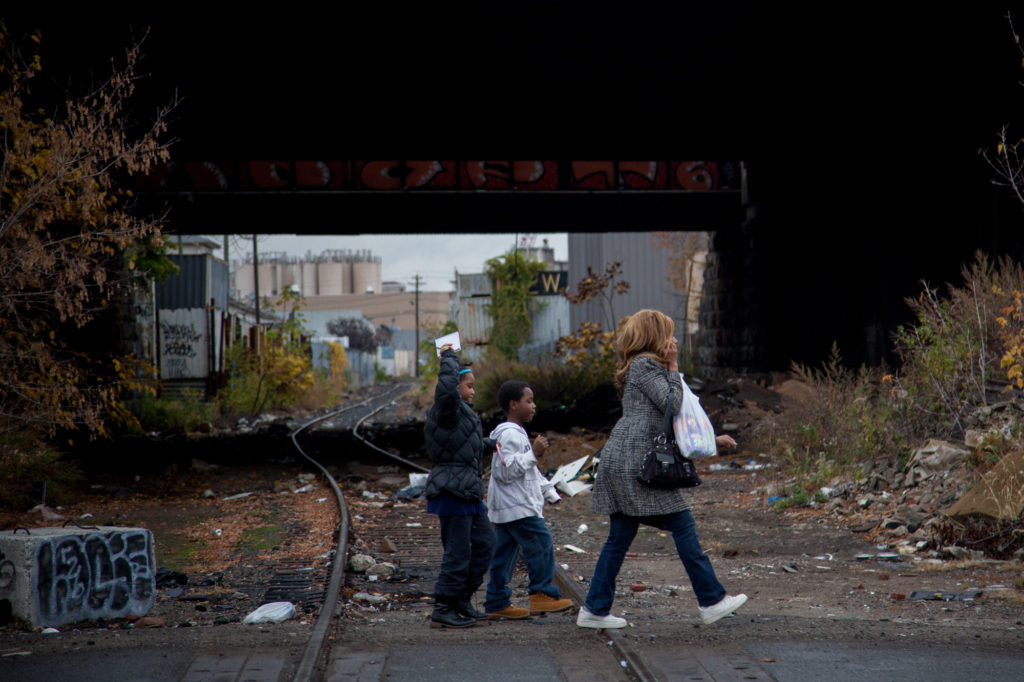
New Jersey Railroad Ave & Raymond Boulevard
Following Railroad Avenue north past Shorty’s, we end up at the edge of the Passaic River, a nineteenth and twentieth-century shipping canal that, like so many postindustrial waterways across the nation, has been pumped full of toxic chemicals. Just like the soil and groundwater near the railroad tracks behind Shorty’s, the river itself is home to carcinogens. The very final enclosing edge of the Ironbound, the Passaic River, is now one of the largest superfund cleanup projects in the history of the Environmental Protection Agency. There’s no sign designating the site a superfund and the water seems to be a pretty quiet place. Three Newark police officers gaze out to the river on their stationary motorcycles. Above us, commuter rail lines reach out of Newark like tendons, stretching over the Passaic and into Jersey City and lower Manhattan.
We follow the river east onto Lister Avenue, home to another superfund site, two EPA facilities of interest, and seven known contaminated sites. The most infamous of these sites is the Diamond Alkali superfund, also known as Diamond Shamrock.
In 1983, right before the Diamond Shamrock facility was declared a superfund site, EPA tests showed dioxin levels as high as 51,000 part per billion at the facility itself and 1,000 parts per billion throughout the adjoining residential and business area. Both of these measurements dramatically exceeded public health standards, which the Center for Disease Control sets at 1 part per billion in soil concentration.
Located at 80 and 120 Lister Ave, Diamond Shamrock produced Agent Orange, a chemical defoliant that was shipped to the United States military during the Vietnam war. Agent Orange contains an impurity called 2,3,7,8-TCDD, better known as dioxin, a colorless and odorless chemical. Like lead and chromium, it’s a human carcinogen.
Much like Cookson Pigments, Diamond Alkali was illegally discharging chemical waste into the Ironbound soil, water and air. The discovery of carcinogenic levels of dioxin along Lister Avenue set off an over 30-year environmental justice battle in the north Ironbound that began with a suit filed against Occidental Chemical Company by the Ironbound Health Advisory Council in 1987 and culminated in the containment of soil and debris in an impermeable cap in 2012.
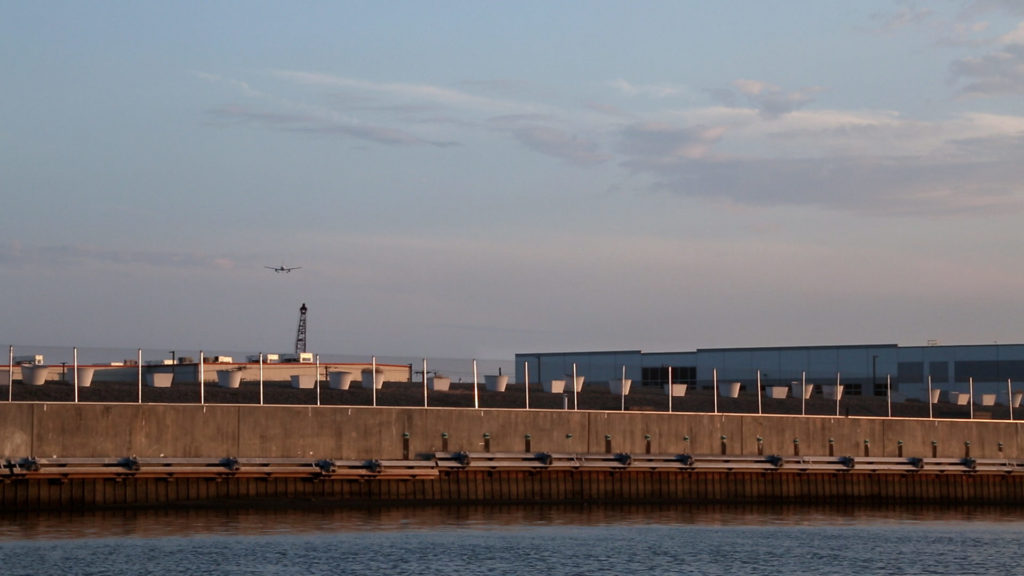
But the cap that sits behind the fences that enclose 80 Lister Avenue only solved one of the many problems dioxin posed in the Ironbound. With a string of dioxin spills throughout the 1980s around the United States, scientists and publics learned the hard way that dioxin is an extraordinarily mobile toxin. It leaches into soil and can attach to moving objects. So, when Diamond Alkali discharged dioxin waste around their facility and in the nearby Passaic River, the chemical made a permanent home in the riverbed sediment. It also stuck to the bottoms of workers’ shoes and on truck tires, which allowed it to move around the Ironbound community, contaminating the neighborhood pool. Although the dioxin hotspots around the Ironbound and at the 80 and 120 facilities were vacuumed, put into steel drums, and buried in a cement casing at 80 Lister Avenue, the Passaic River still contains high levels of dioxin and a string of other chemicals. Today, 7 other companies along Lister Avenue are known contaminated sites under EPA watch because they pose a risk of further polluting the Passaic.
Early afternoon and the water is dark blue, almost black. Later today it will rain, and when it does, the contents of the river will move again – pike fish and PCBs, dioxin and mercury.

112 Lister Avenue
We make a left off Lister Avenue onto a driveway that leads us to the offices for ISS Carrier LLC, which is located on the eastern section of the former Diamond Alkali plant site, though the tract is no longer owned by the Diamond company. There are three buildings at 112 Lister Avenue. Two are early-twentieth-century, dilapidated and vacant industrial plants and the third is a three-story commercial trailer that ISS, a New Jersey Transport company, runs their business out of. We walk beside the first industrial building, the year 1912 inscribed above its entryway. Within the structure, supporting beams of pitch-pine peer out a ruddy brown.
When we meet David, a Guianese mechanic who has been working for ISS for 4 years, he is sitting on a tire slanted against the 1912 building. David explains that he came to work here after Hurricane Sandy to help his sister who owns the business. “She had had trouble with Hurricane Sandy,” he says. “She had 15 trucks go, all of them flooded. The water was 7 feet high.” David gives us a tour of the site––the single truck that made its way up a mound of dirt 6 feet high behind the 1912 building during the superstorm; the current fleet of trucks lined up for repair; the city of tires he inspects each day with a hammer and then sorts; and finally, the tool shop.
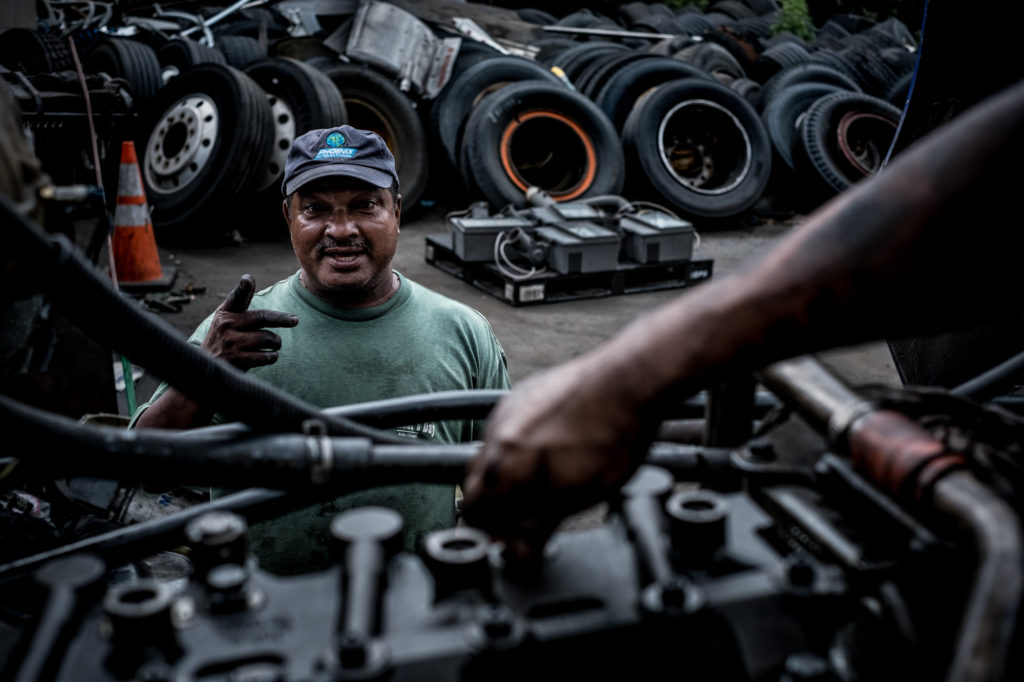
As we tour the worksite, David starts to talk about the history of 112 Lister. “They used to make chemicals here,” he says as he walks us through the building constructed in 1917. “There is a guy in the front who worked there for 50 years and he told me.” We go to visit David’s friend, Penn, who is working at the front of 112 Lister. When we find him, Penn is monitoring a well––he’s wearing gloves and thick jeans, despite the fact that it’s in the mid-90s today. Penn tells us that this was formerly a waste management facility, not Diamond Alkali (whose old facilities we can see beyond the fence to our left), but a company called Chemical Waste Management of New Jersey. Penn’s job is to monitor the now vacant facility to make sure there isn’t any standing water. Penn isn’t interested in waxing historical like David, so we thank him for sharing a bit of history and make our way back to the ISS trailer.

Penn has been working at the site since 1969. 
Penn tests the soil and monitors water levels
The property where David, Penn and a handful of other ISS employees work, is owned by two different companies. The company that owns the front lot is IC Holdings, INC/Waste Management, otherwise known as Chemical Waste Management of New Jersey. CWM began operation at 112 Lister Avenue in 1984, just one year after dioxin was found throughout the Lister Avenue Diamond plant and on neighborhood streets. While in operation, CWM stored hazardous waste in containers and tanks at the facility. Since their investigation by the NJDEP, the containers and tanks have been removed. However, soil and water testing of the site has shown contamination of shallow and deep groundwater as well as contaminated soil. The water is contaminated with volatile organic compounds, including chlorobenzene, benzene, tetrachloroethylene and trichloroethene, and semi-volatile organic compounds, as well as pesticides and metals. Soil contamination includes pesticides and arsenic.
Although David’s home is with his wife in New York, he spends four nights a week in the ISS work trailer. “If I go to New York every day, I deal with traffic, so I just sleep here, you know. I’ve got a shower and whatever here. I’ve got everything upstairs. I’ve got a room and a bed and stuff.” And so David has made the Lister Avenue site his home away from home. dBut just like the chromium ghosts of Vanderpool street, there are chemical hauntings here, too, both in the form of the dioxin contaminated water and the arsenic-laced soils that lie beside ISS.
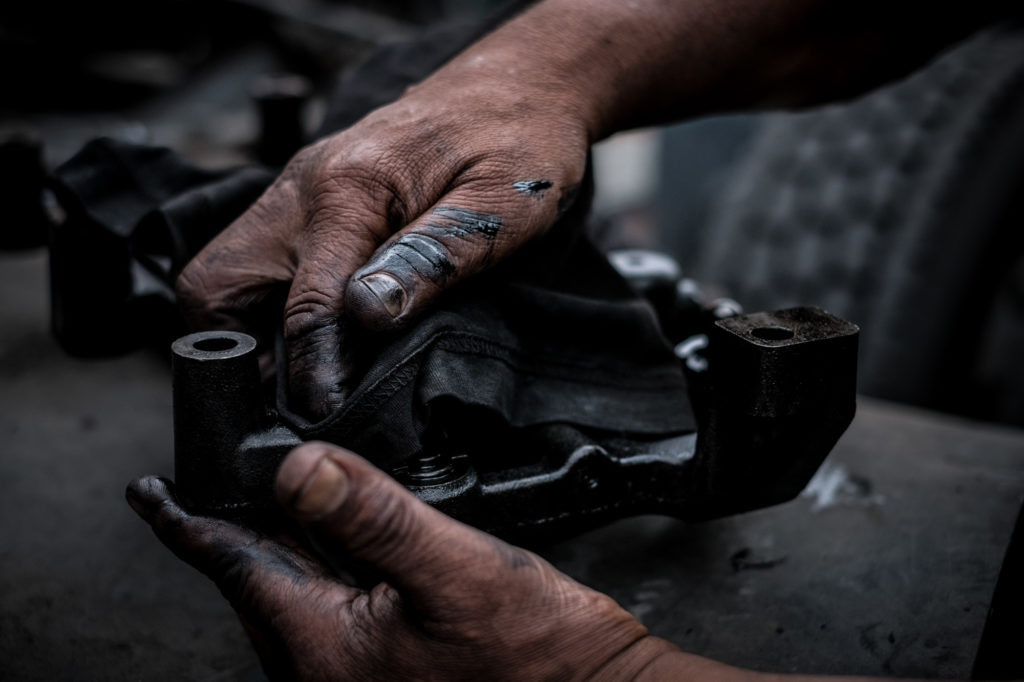
Soil is no small deal at 112 Lister Avenue. David’s hands are caked in it. His fingernails are pockets of dirt, rich as tree rings. As a mechanic, David’s body is constantly interfacing with the soils of Lister Avenue. We turn the corner past the tool shop and David begins to tell us about his garden, a shockingly lush network of plants: from spinach to Italian squash, habanero peppers and eggplant to scotch bonnet peppers and, somehow, a flowering pineapple. This is another way that David has made Lister Avenue a home. It’s humbling to walk around David’s garden because the kind of care he has put into this landscape stands in stark contrast with the derelict chemical spaces that define Lister Avenue and the boundaries of the Ironbound more generally. David’s garden is a hopeful place; a place that suggests that even out of the chemical rubble, life persists.
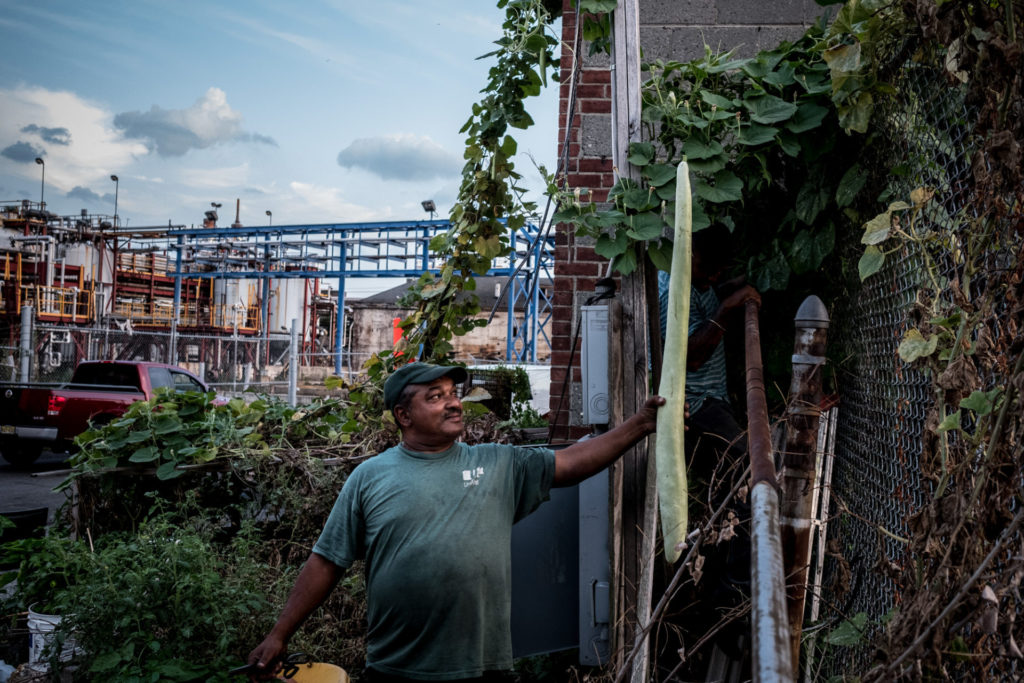
But the garden is terrifying, too. Although David has placed most plants inside of old tires or truck refuse, the garden borders a fence that clearly encloses a highly contaminated tract of land that is currently under investigation and is, according to a 2016 tax map, owned by Diamond Shamrock Chemical. “If the food was contaminated the plant would have died,” David says when the photographer and I express concern. But it doesn’t always work that way. Human exposure happens over time and plants are often nonvisual carriers of the insidious chemicals industrial polluters have poured into and onto our earth. I have to admit that it’s hard to argue with David about his garden. I am rooting for it. I want the garden, and the care that he has put into it, to survive. “I pick, I give away. I give to my sister, the girl in the office,” he says. “I don’t take everything for myself.” David says that a company comes to test the well that runs along the fence every three months and this is enough to quell his worry about contamination. Maybe he is right, but the history of chemical dumping, and insufficient cleanup by the companies responsible, along streets like Lister and Vanderpool invites skepticism.
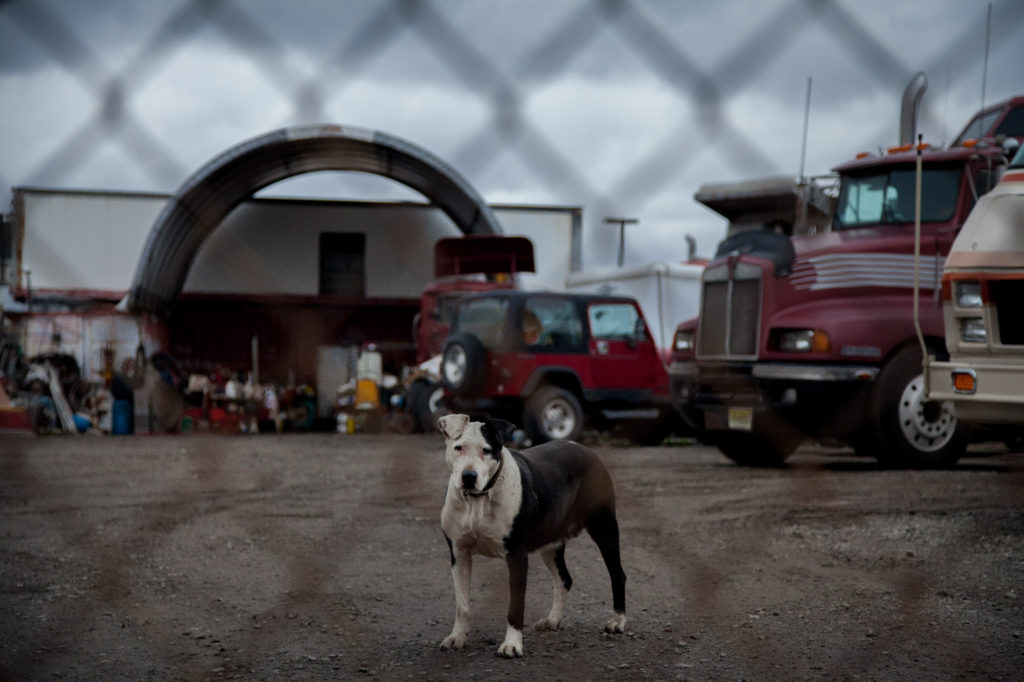
23 Ester Street
By the time we leave David, I realize that Hurricane Sandy did more than move ISS’s trucks around Lister Avenue. The storm brought the polluted waters of the Passaic into the ISS tool shop, into the garden. It moved around the arsenic soil that Penn monitors. Every minor or massive flooding event from here on out will do same, at least until the contaminated soil in the Passaic is dredged and removed from the river.
The waters that rose and swirled along Lister Avenue during Hurricane Sandy didn’t stay there. They spread down Ester Street, a residential corridor one block from Lister Avenue where Carmen Reyes lives. Reyes is one of the last residents left on her block and her house is a third of a mile from Diamond Alkali. Her former neighbors were families and young couples, she tells us. Tax maps show that as of 2016 at least four of the vacant houses on the block are owned by the New Jersey Department of Environmental Protection.
Along with Ester Street, the contaminated waters covered the rail lines of Oak Island Yard and CSAO, as well as the yard’s mercury contaminated superfund stream. The waters flooded Cookson Pigments, Shorty’s skate park, and its volleyball court parking lot. Storms like Sandy make apparent the carcinogenic remnants of industrial capitalism that lurk around the Ironbound community.
These storms also make those carcinogenic remnants extremely mobile. And while life goes on––David tends his garden; the skaters build another ramp beside the Cookson Pigment Plant––there will be more hurricanes and hundred-year floods. Knowing all of this, the companies that polluted the Ironbound have a moral if not legal responsibility to remediate the Ironbound. The question now is what exactly remediation means beyond physically removing contaminants. In a second suit against Cookson Pigments, the city wrote that it is time for the companies that polluted Vanderpool Avenue to “pay Newark the millions of dollars in tax revenues that they deprived the City, and enable us to transform Newark into a safer and healthier City that we can all believe in.” Every contaminated edge of the Ironbound, and the communities that are bound to them, deserve this.
